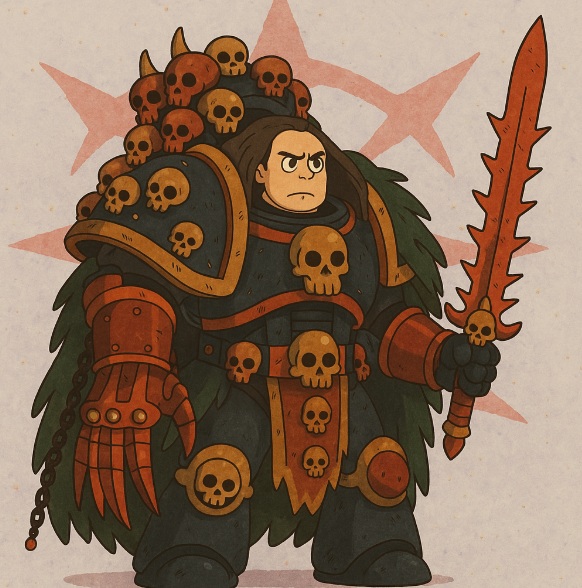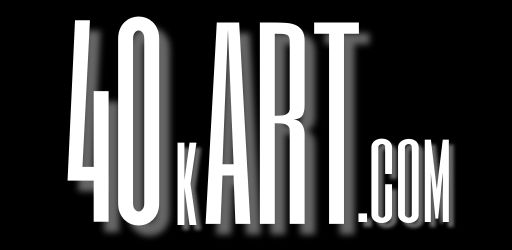Abaddon the Despoiler in Ghibli Style

Abaddon Reimagined: A Ghibli-Style Blend of Menace and Melancholy
The Warmonger in a Softer Light
In this Ghibli-style reimagining of Abaddon the Despoailer, the infamous warlord of Chaos is presented with a blend of intimidation and charm. His armor, still drenched in skulls and adorned with spikes, maintains its dark and brutal design, but it’s rendered with softer lines and rounded edges that give it an almost toylike appeal. The exaggerated proportions—oversized pauldrons, thick limbs, and massive weapons—feel more stylized than terrifying. His facial expression is determined, but not monstrous, striking a balance between fury and focus. The Eye of Horus symbol and the star of Chaos behind him ground him firmly in his role as the Arch-Warmaster, yet the Ghibli-style softens the darkness just enough to invite curiosity rather than fear. It’s a bold mix of menace and playfulness, wrapping his grim persona in an unexpectedly charming aesthetic.
Ghibli Chaos Aesthetics
The art captures the grim gothic aesthetic of Warhammer and filters it through a whimsical, hand-drawn lens that evokes old animated tales. Every skull, spike, and armored plate is simplified, but still recognizable—like someone lovingly sculpted each detail with a childlike sense of fascination. The red and gold color scheme feels rich and saturated, with a textured background that mimics aged parchment, adding a sense of ancient legend. The Talon of Horus and the daemon sword Drach’nyen are faithfully reimagined with jagged but cartoonish flair. Even the cloak of scaled fur draping his shoulders feels more like something out of a forest spirit’s design than a battlefield trophy. It’s a look that makes you think, “Yes, he’s a villain—but maybe in a story where you could understand why.”
The Lore of Abaddon the Despoiler
Abaddon the Despoiler is one of the most iconic and feared figures in Warhammer 40K lore. Once the First Captain of the Luna Wolves (later the Sons of Horus), he served under the traitor primarch Horus during the Horus Heresy. After Horus was slain by the Emperor, Abaddon refused to take his father’s place, seeing Horus’s failure as weakness. Instead, he forged his own path, uniting the Traitor Legions and leading thirteen massive Black Crusades from the Eye of Terror against the Imperium. Over the millennia, Abaddon has become the ultimate champion of Chaos Undivided, wielding ancient weapons and immense power, respected even by daemons. Though hated by the Imperium, he is a master strategist and warrior, with ambition that rivals the primarchs themselves.
A Monster with Purpose
This Ghibli-inspired piece doesn’t strip Abaddon of his dread, but it does bring him closer to the viewer. His eyes still burn with conviction, and his armor is still bristling with the trophies of war, but there’s something more readable in his expression. He looks less like a monstrous destroyer and more like a warrior bound by fate, shaped by betrayal, vengeance, and a twisted form of loyalty. His presence is powerful, but also strangely melancholic—as if this version of Abaddon is carrying the burden of history, not just reveling in destruction. The chains, claws, and fangs now feel like symbols of a broken legacy rather than just instruments of war. It’s a portrait of a villain who believes he’s the hero of his own saga.
The Beauty in the Brutal
In this stylized rendering, the eternal war and chaos of Warhammer are filtered through a gentler narrative lens. It shows that even the most feared warlords can be seen through a different perspective—one that doesn’t erase their evil but makes it easier to understand. The careful attention to armor detail, the rich color tones, and the confident but calm pose all help tell a story beyond battle. It’s a version of Abaddon that invites both fear and sympathy, a duality rarely explored so visually. While he may command the legions of Chaos, here he’s more than a brute—he’s a character with depth, fury, and the burden of destiny. It’s a reminder that every villain has a story, and sometimes, it’s written in softer strokes than you’d expect.

